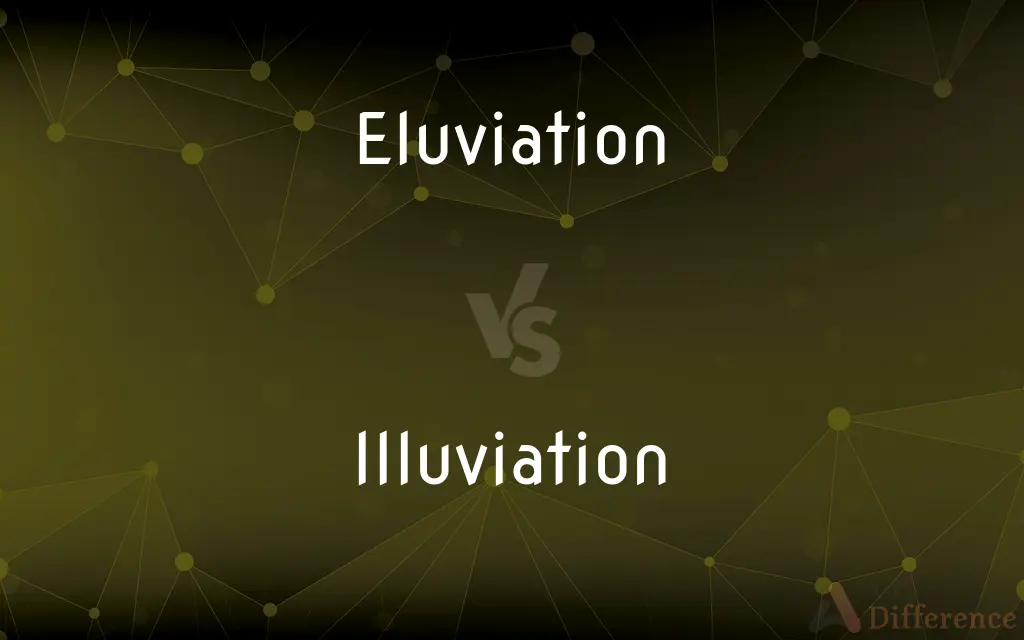Eluviation vs. Illuviation — What's the Difference?
By Tayyaba Rehman & Fiza Rafique — Updated on September 12, 2023
Eluviation is the process where minerals and nutrients are leached from the upper soil layers. Illuviation is the process where these leached materials are deposited in lower soil layers.

Difference Between Eluviation and Illuviation
Table of Contents
ADVERTISEMENT
Key Differences
Eluviation is a soil science term referring to the movement of nutrients, minerals, and organic matter out of the upper layers of soil due to the percolation of water. It typically occurs in the horizon referred to as the "E-horizon" (eluviation horizon) of soil profiles. On the other hand, Illuviation is the corresponding process where the leached materials accumulate in the lower layers of the soil, commonly in the "B-horizon" (illuviation horizon).
Eluviation essentially is a process of removal or "washing out." It plays a crucial role in soil development and is affected by factors like climate, soil type, and vegetation. Illuviation is the complementary "addition" process, which also impacts soil structure, fertility, and overall ecology. The substances involved in both processes usually include ions like calcium, magnesium, and potassium, among others.
Eluviation can lead to soil depletion if not balanced by processes like mineral weathering that replenish the soil's nutrient content. It is of concern in agriculture where nutrient-rich topsoil is essential. Illuviation contributes to the formation of various soil layers and is critical in determining soil properties like acidity and alkalinity, which are essential for different types of vegetation.
Both Eluviation and Illuviation are critical for understanding soil profiles, which are essential in various fields like agriculture, forestry, and environmental science. While Eluviation might lead to issues like soil erosion or nutrient loss, Illuviation can sometimes result in hardpan formation, affecting water movement and root penetration.
Comparison Chart
Process
Leaching from upper layers
Deposition in lower layers
ADVERTISEMENT
Soil Horizon
Typically occurs in the "E-horizon"
Typically occurs in the "B-horizon"
Impact on Soil
Can lead to nutrient loss
Can lead to hardpan formation
Importance
Vital for understanding soil depletion
Vital for understanding soil layer formation
Role in Ecology
Affects soil fertility and structure
Affects soil properties like acidity and alkalinity
Compare with Definitions
Eluviation
Movement of minerals from upper soil layers.
Eluviation occurs in the topsoil during heavy rainfall.
Illuviation
Accumulation process in soil science.
Illuviation affects the soil's water retention ability.
Eluviation
A form of soil erosion at the microscopic level.
Eluviation is a significant concern in sustainable agriculture.
Illuviation
Formation of hardpan layers in soil.
Illuviation can cause problems in water drainage.
Eluviation
Leaching of nutrients due to water percolation.
Eluviation causes loss of important nutrients in farmlands.
Illuviation
Complementary to Eluviation.
Illuviation usually follows eluviation in the soil horizon.
Eluviation
"Washing out" of soil components.
Soil acidity can increase due to eluviation.
Illuviation
Deposition of leached materials in lower soil layers.
Illuviation contributes to soil layer formation.
Eluviation
Removal process in soil science.
Eluviation can lead to soil depletion over time.
Illuviation
"Adding in" of soil components.
Illuviation often affects soil alkalinity.
Eluviation
The lateral or downward movement of dissolved or suspended material within soil when rainfall exceeds evaporation.
Illuviation
The deposition in an underlying soil layer of colloids, soluble salts, and mineral particles leached out of an overlying soil layer.
Eluviation
The sideways or downward movement of dissolved or suspended material within soil caused by rainfall
Illuviation
(geology) The accumulation of suspended material and soluble compounds leached from an overlying stratum
Eluviation
Creation of geological deposits (eluvial deposits) by in situ weathering or weathering plus gravitational movement or accumulation.
Common Curiosities
Where does Illuviation occur?
Illuviation usually takes place in the "B-horizon" of the soil profile.
Is Eluviation harmful?
Eluviation can lead to nutrient loss, affecting soil fertility.
What is Eluviation?
Eluviation is the process of leaching minerals and nutrients from the upper soil layers.
What is Illuviation?
Illuviation is the process where leached materials are deposited in the lower soil layers.
Where does Eluviation happen?
Eluviation usually happens in the upper layers or "E-horizon" of the soil.
What substances are involved in Illuviation?
The same materials that are leached during eluviation usually accumulate during illuviation.
What factors affect Illuviation?
Soil composition and the materials leached during eluviation affect illuviation.
Why is Illuviation important?
It's essential for understanding soil profiles and layer formation.
How do Eluviation and Illuviation interact?
They are complementary processes; eluviation removes materials, and illuviation deposits them in lower layers.
Is Illuviation harmful?
Illuviation can sometimes lead to hardpan formation, affecting drainage.
Is Eluviation reversible?
Eluviation is often balanced by processes like mineral weathering.
What factors affect Eluviation?
Climate, soil type, and vegetation are major factors.
What substances are involved in Eluviation?
Calcium, magnesium, and potassium ions are commonly involved.
Is Illuviation reversible?
Illuviation is generally not reversible without specific soil treatments.
Why is Eluviation important?
It's critical for understanding soil depletion and fertility.
Share Your Discovery

Previous Comparison
Hanky vs. Hankie
Next Comparison
Favorite vs. FavouriteAuthor Spotlight
Written by
Tayyaba RehmanTayyaba Rehman is a distinguished writer, currently serving as a primary contributor to askdifference.com. As a researcher in semantics and etymology, Tayyaba's passion for the complexity of languages and their distinctions has found a perfect home on the platform. Tayyaba delves into the intricacies of language, distinguishing between commonly confused words and phrases, thereby providing clarity for readers worldwide.
Co-written by
Fiza RafiqueFiza Rafique is a skilled content writer at AskDifference.com, where she meticulously refines and enhances written pieces. Drawing from her vast editorial expertise, Fiza ensures clarity, accuracy, and precision in every article. Passionate about language, she continually seeks to elevate the quality of content for readers worldwide.
















































